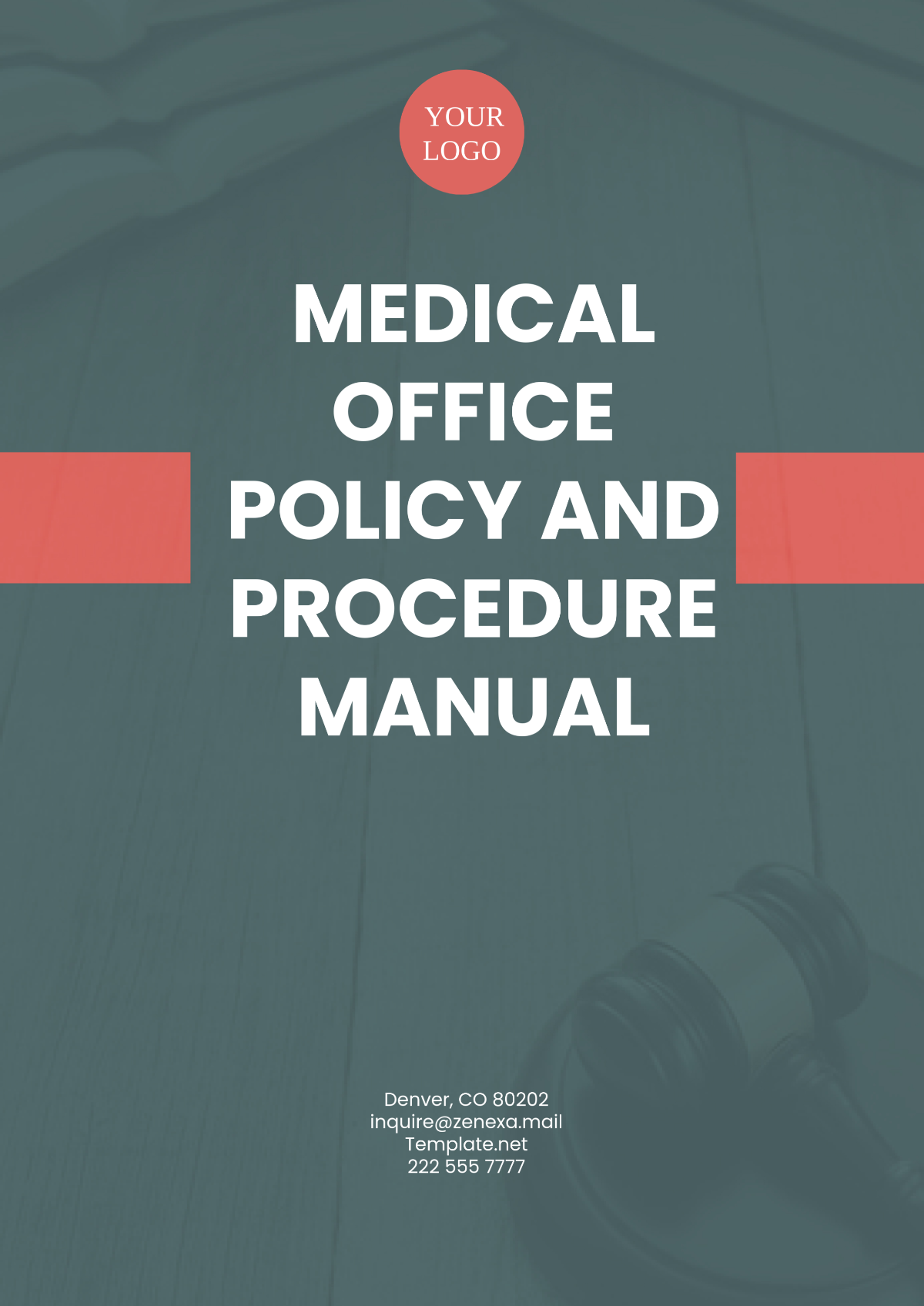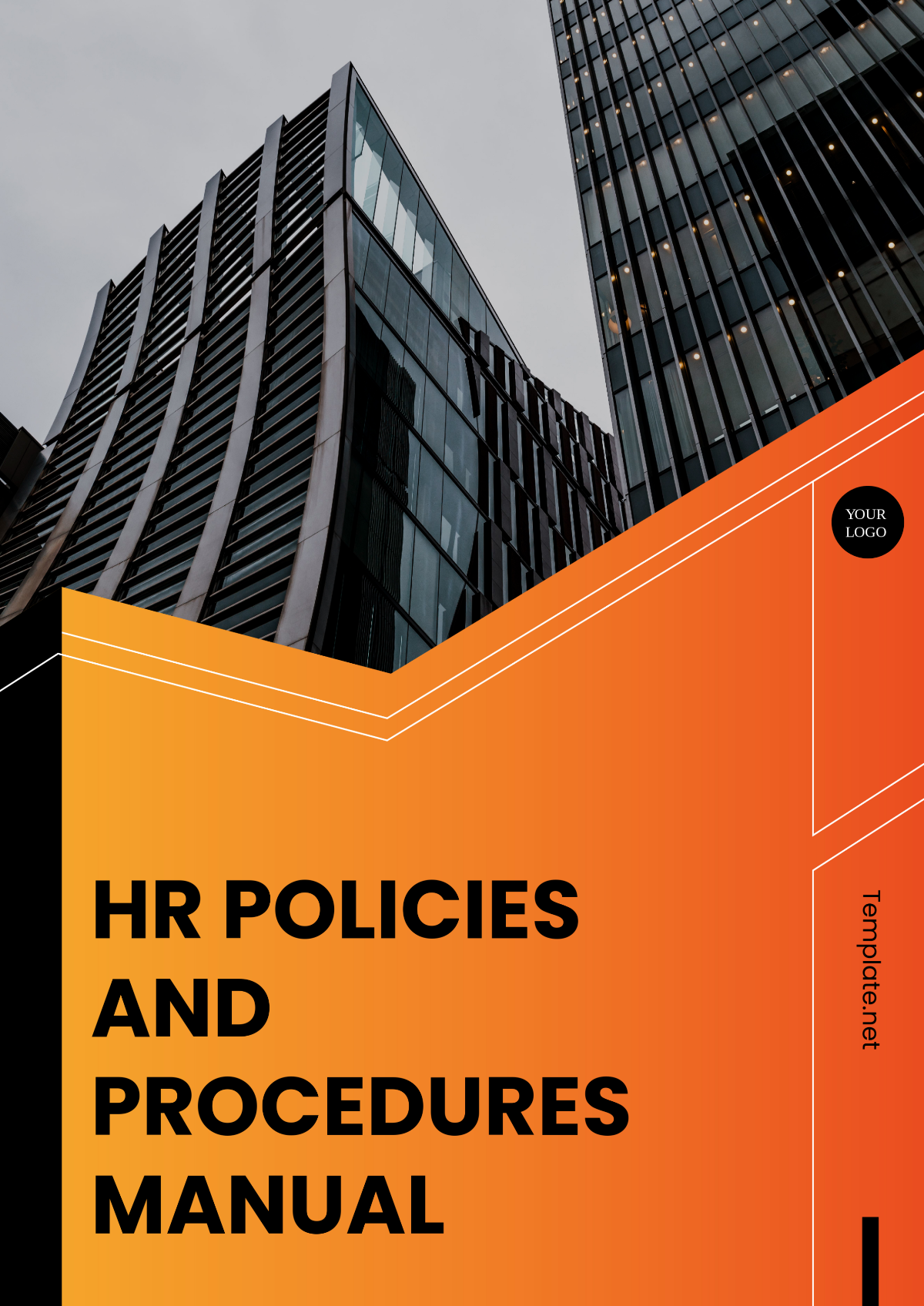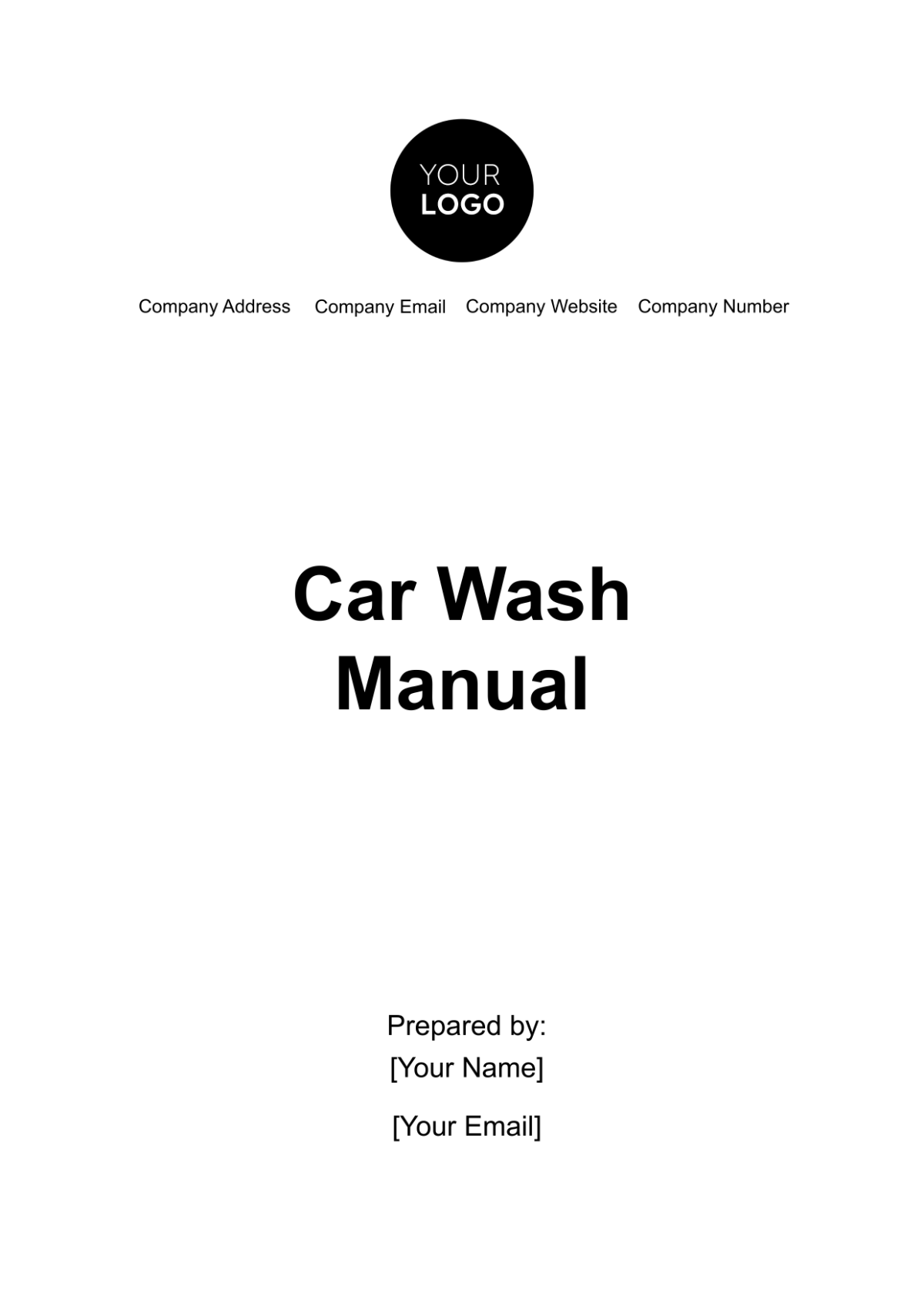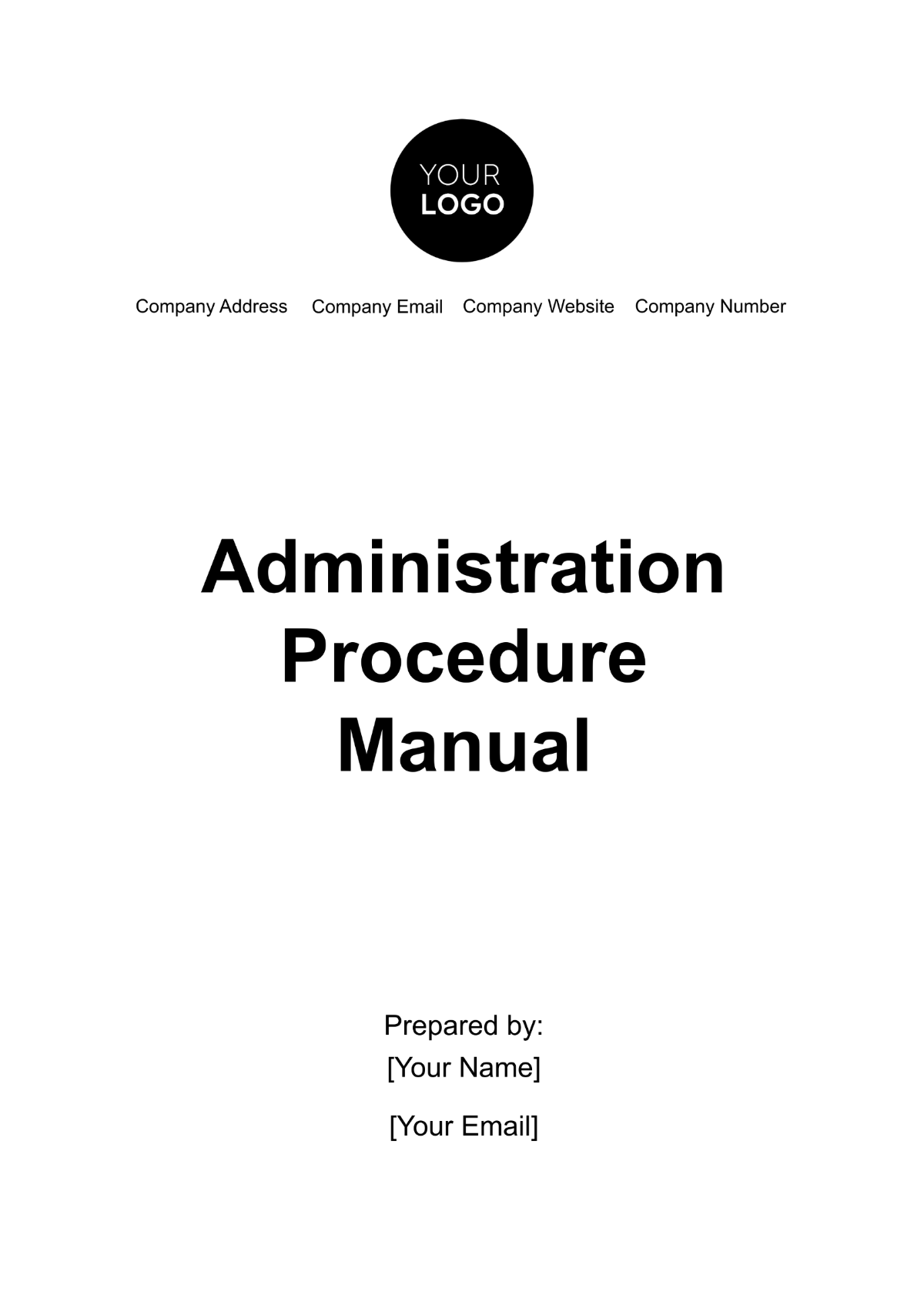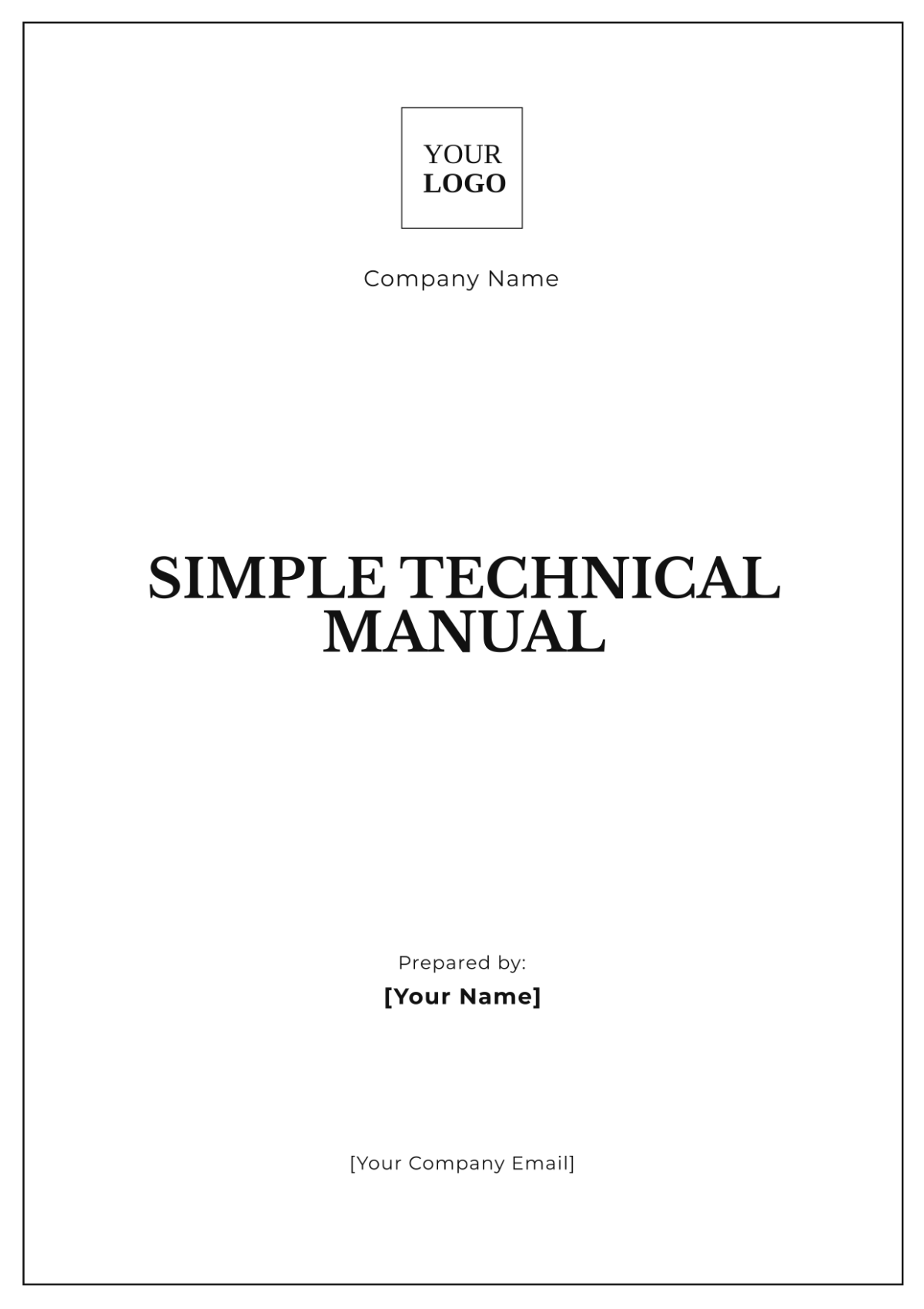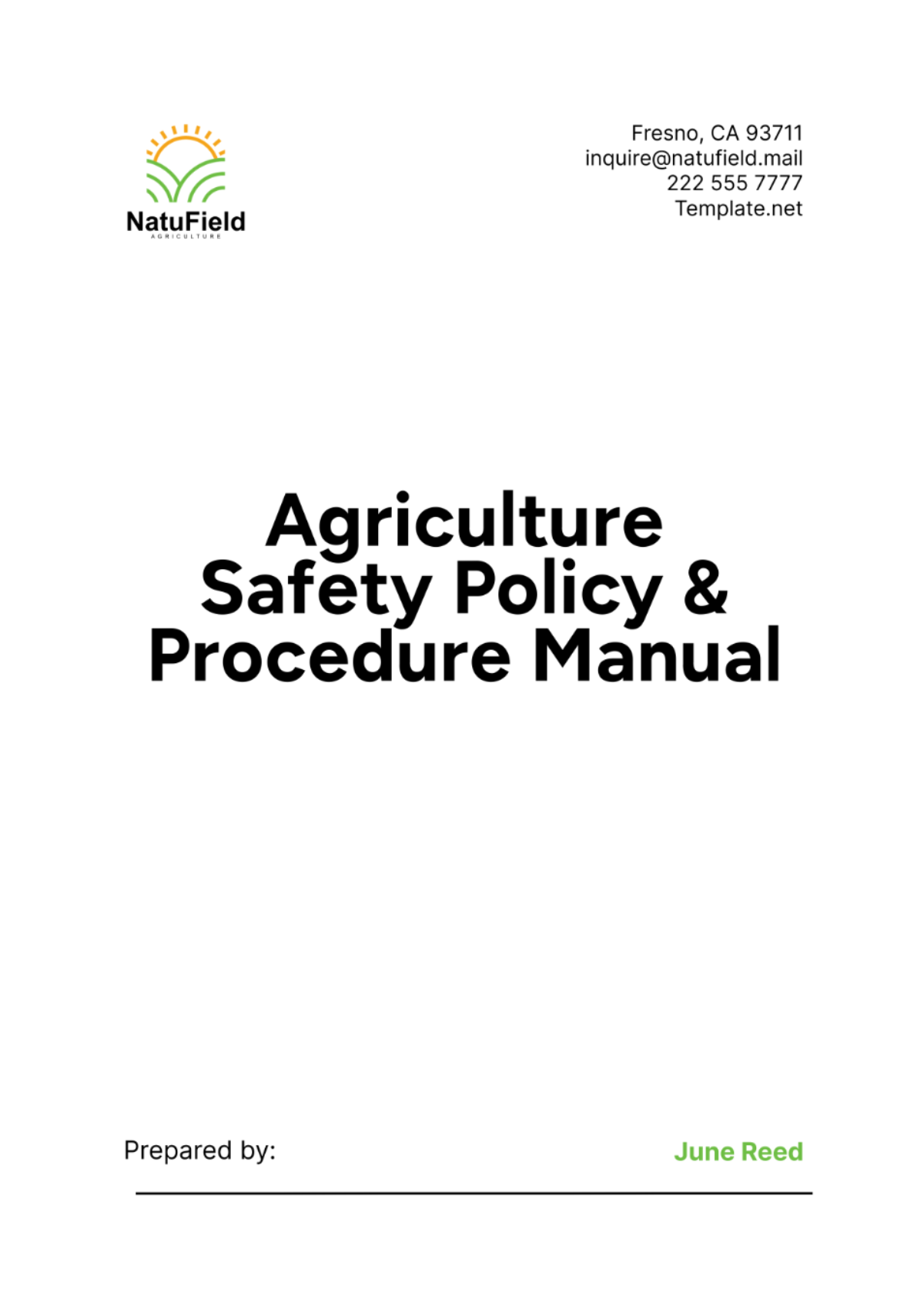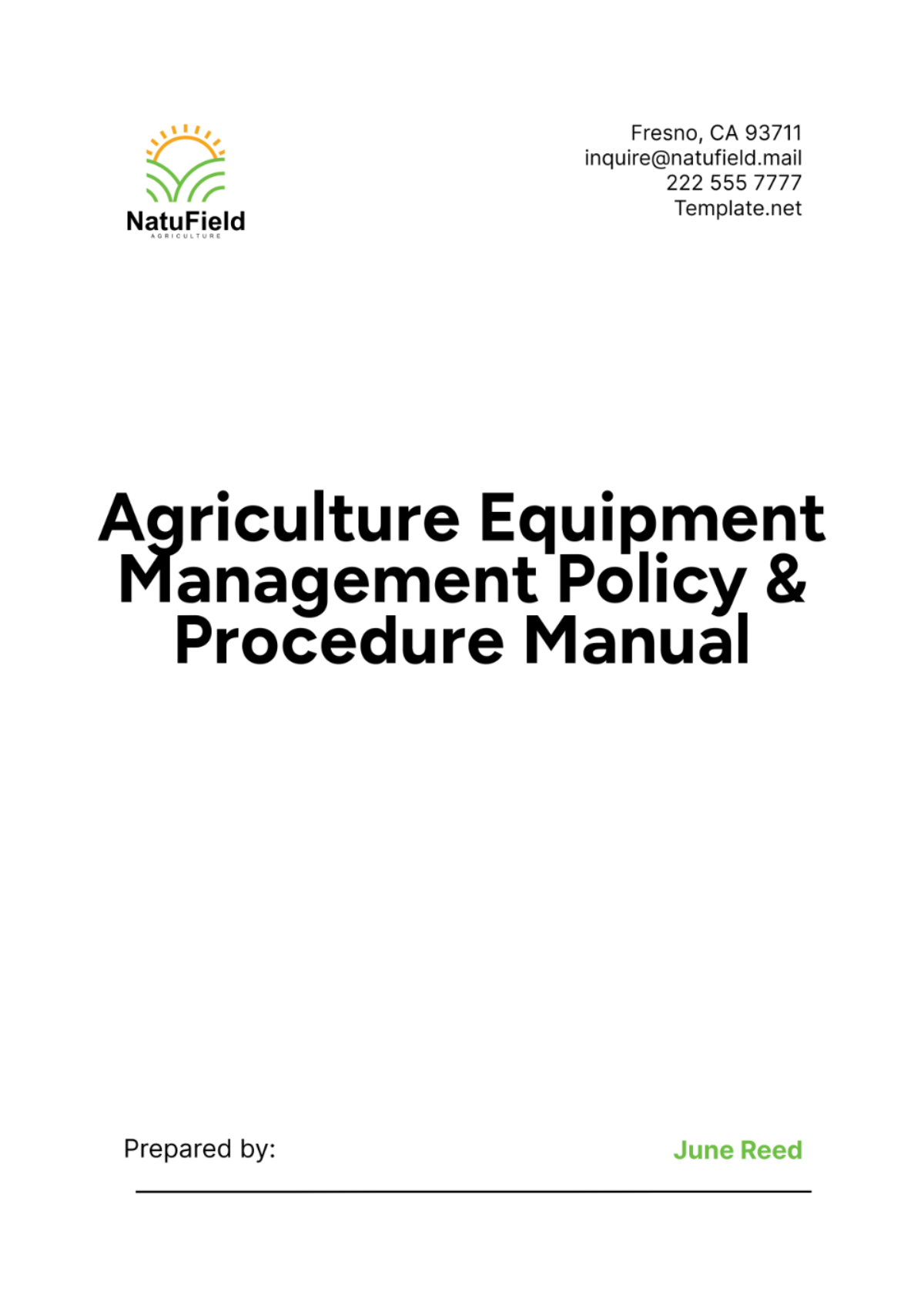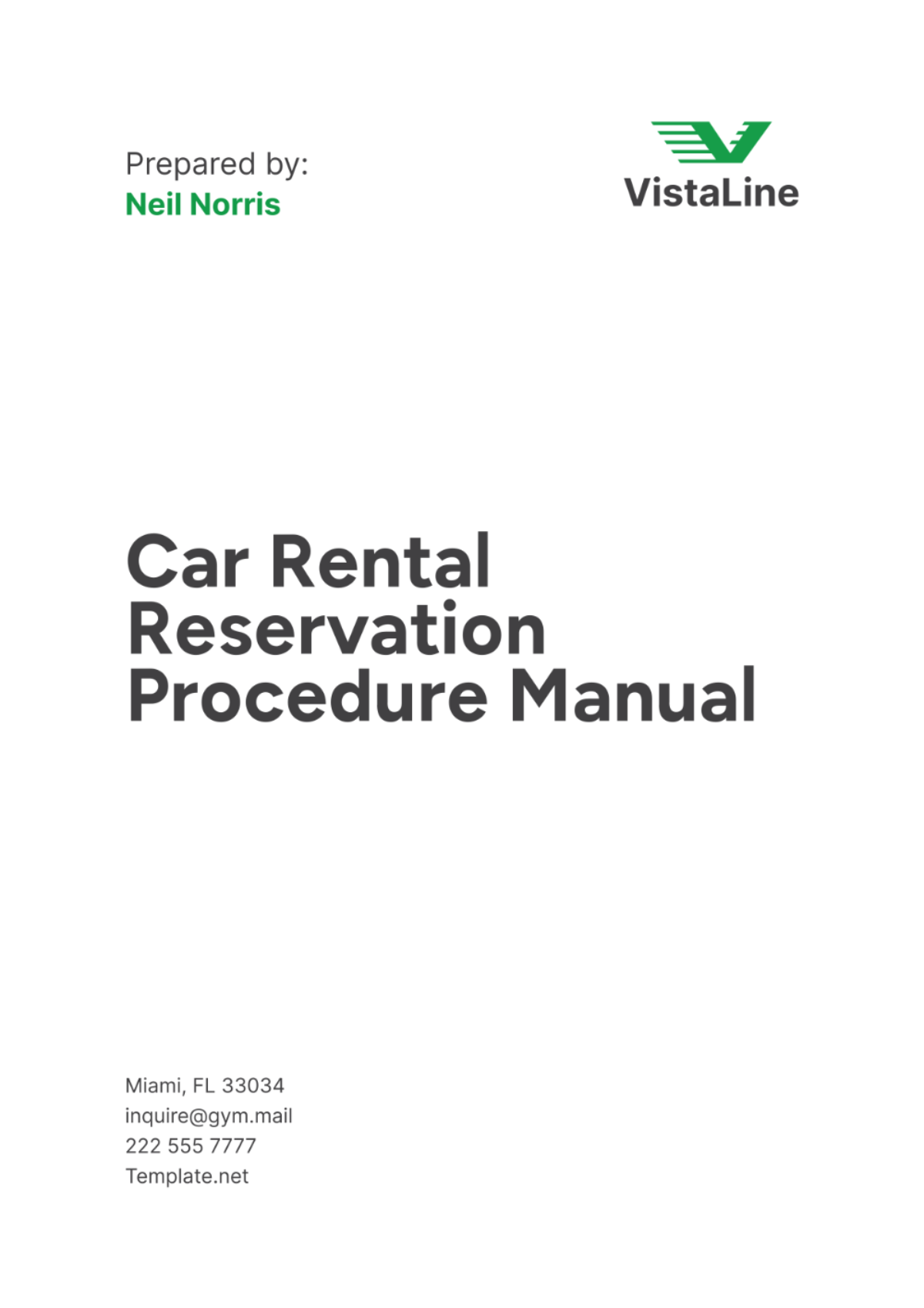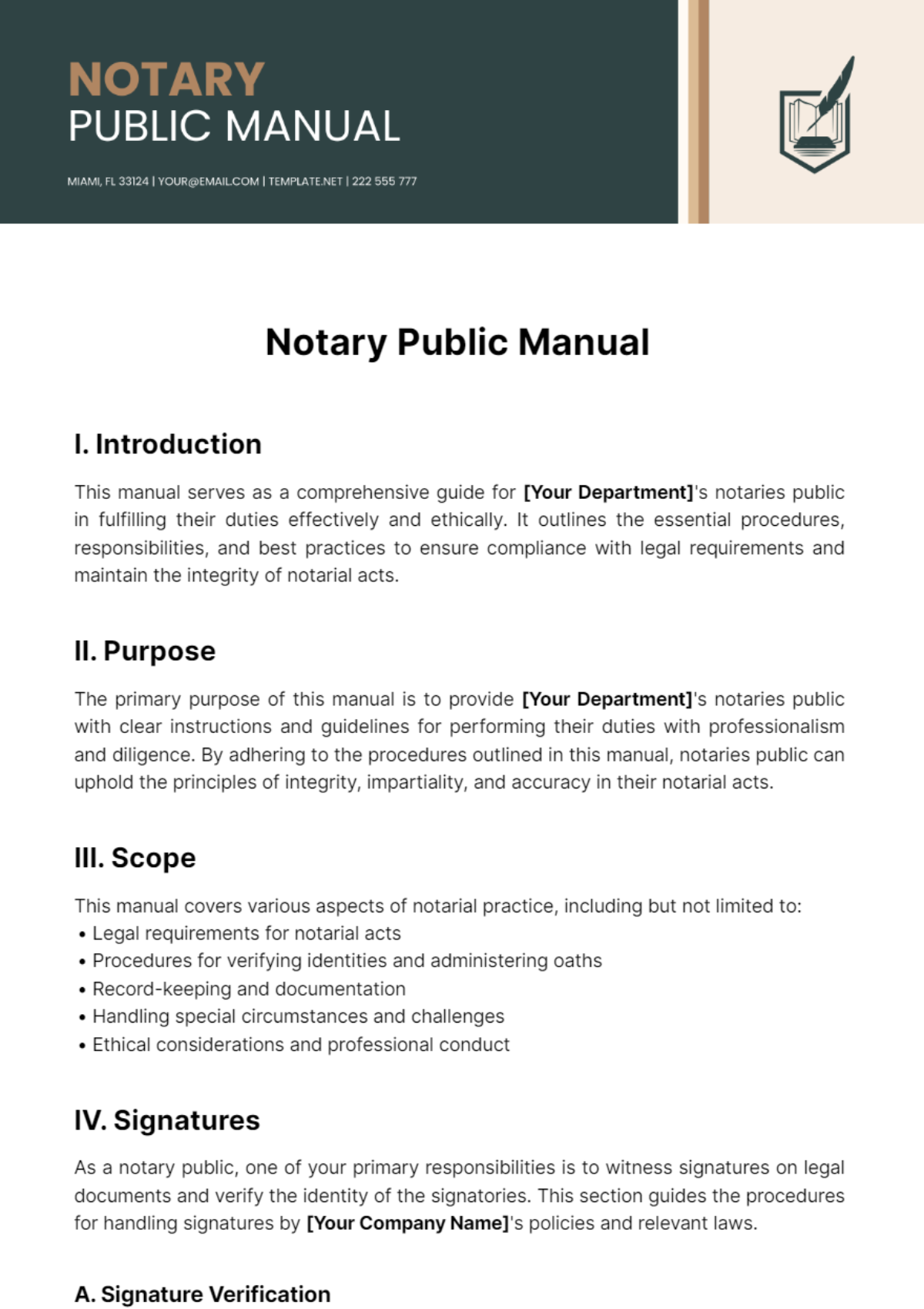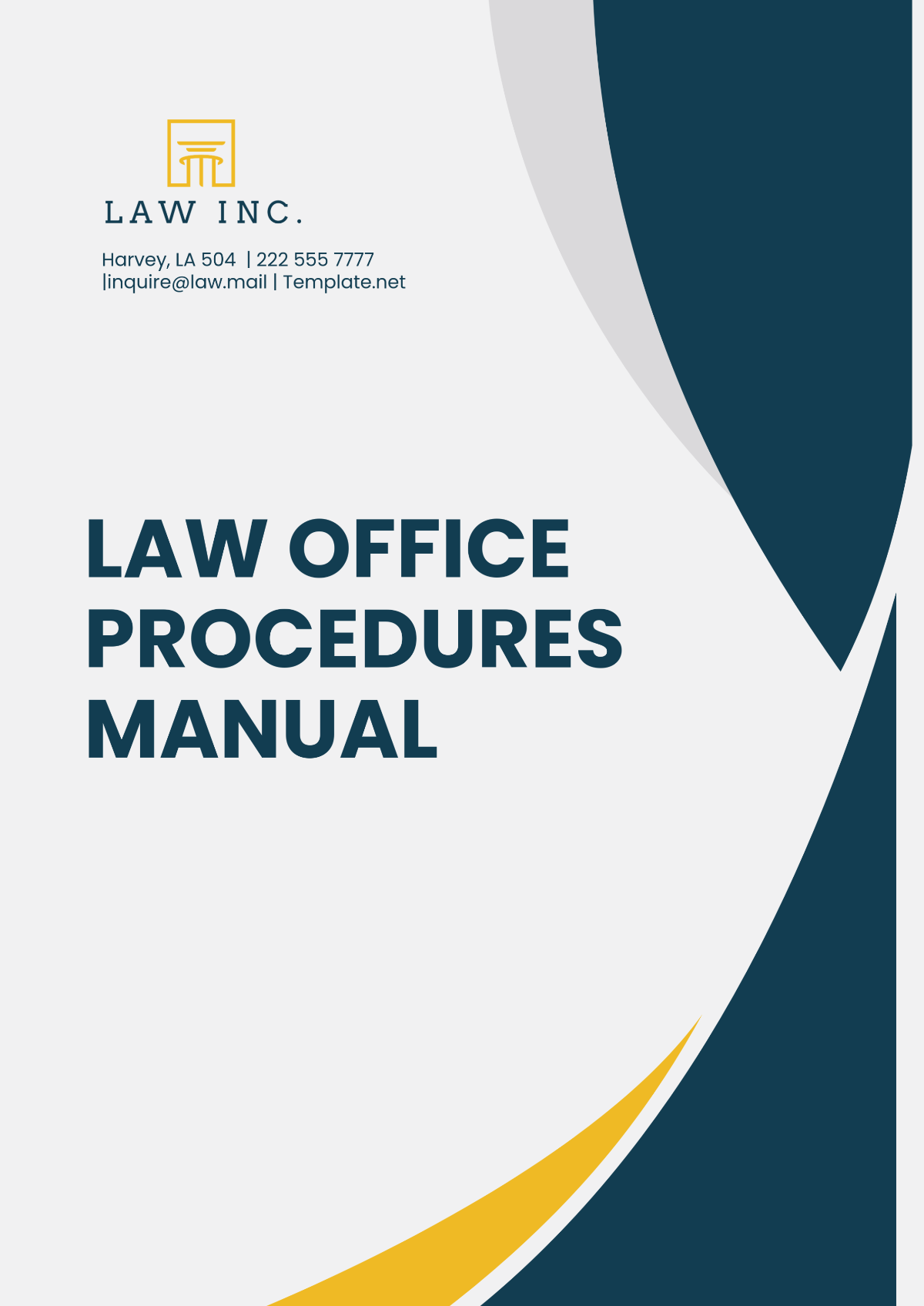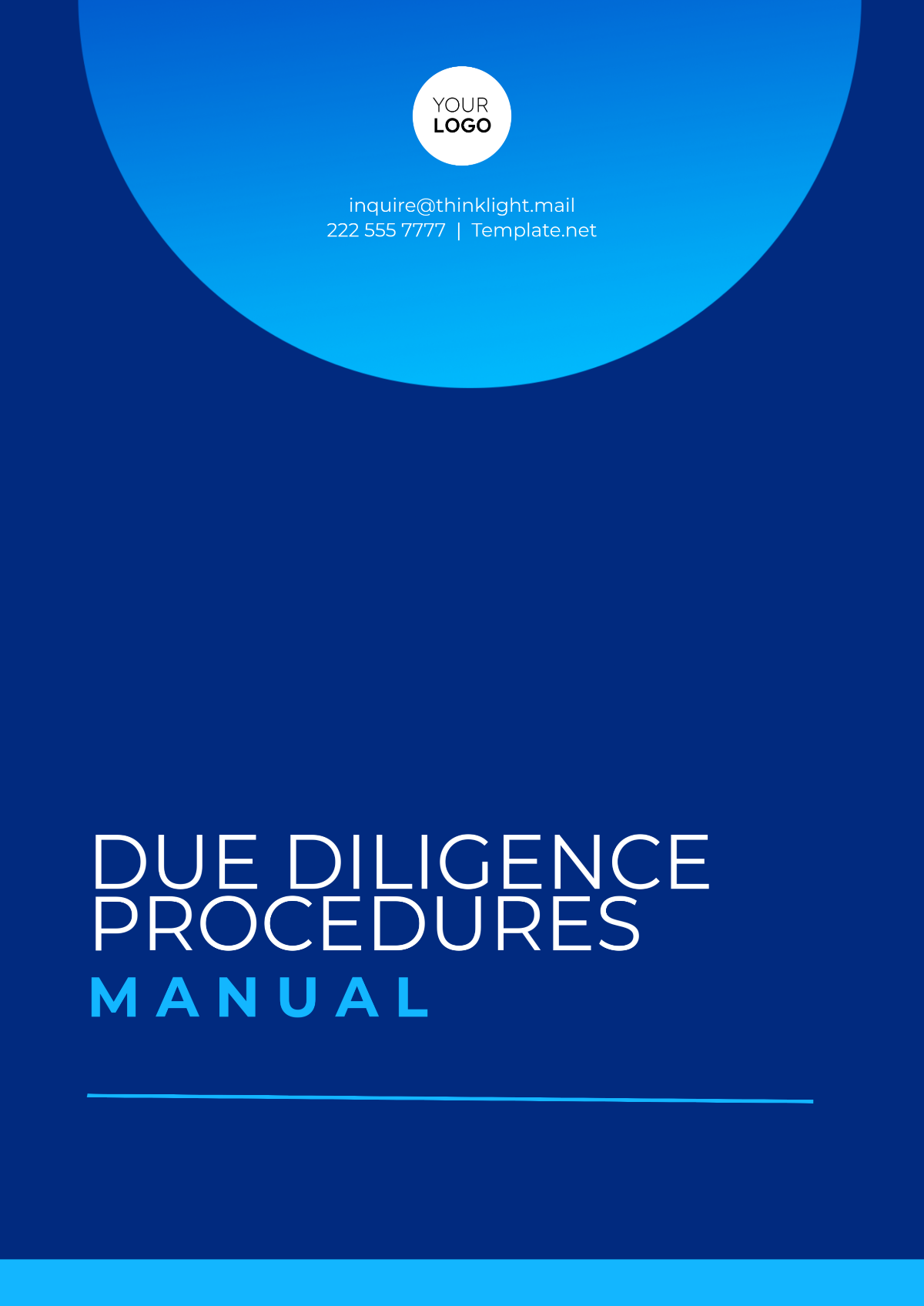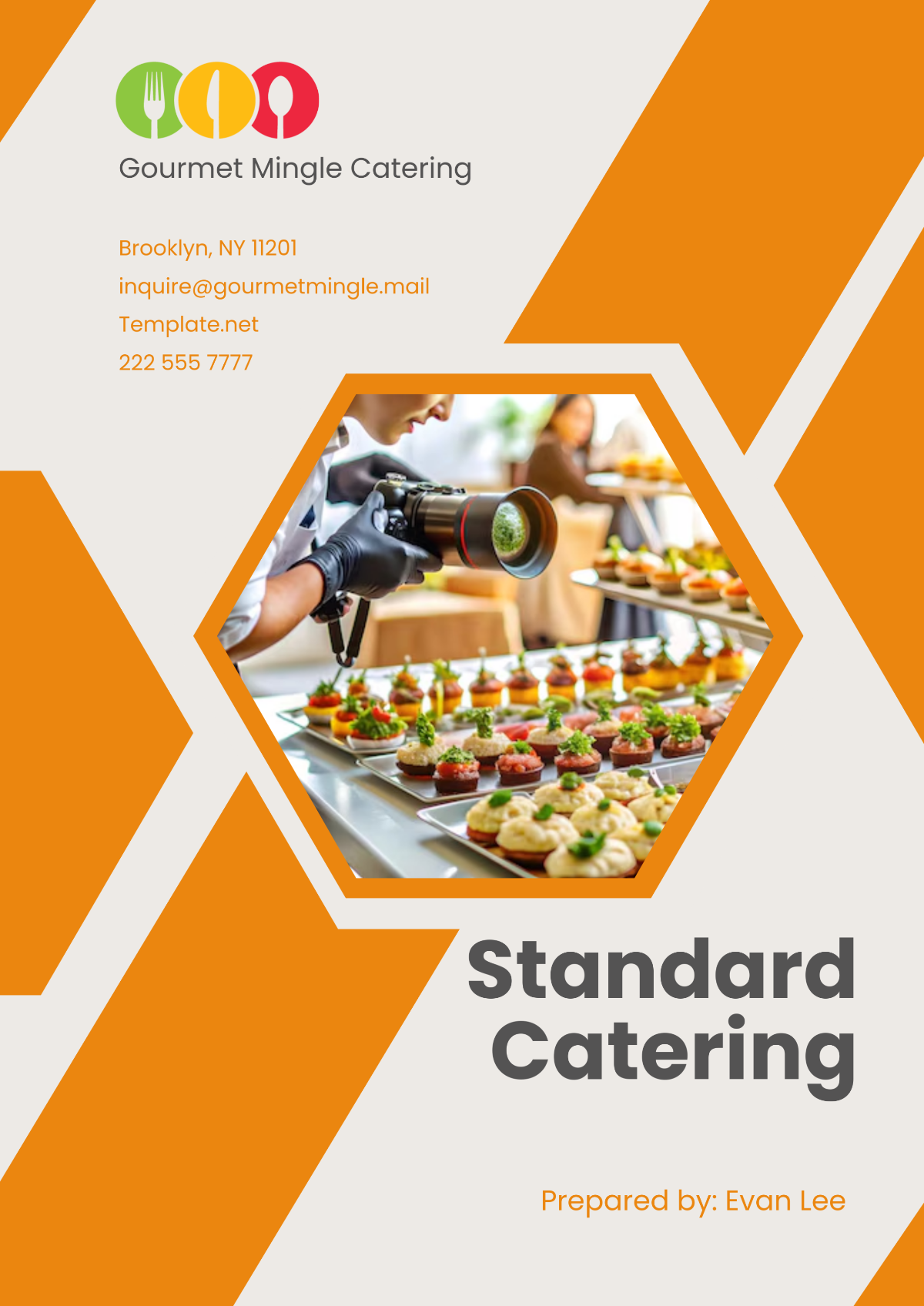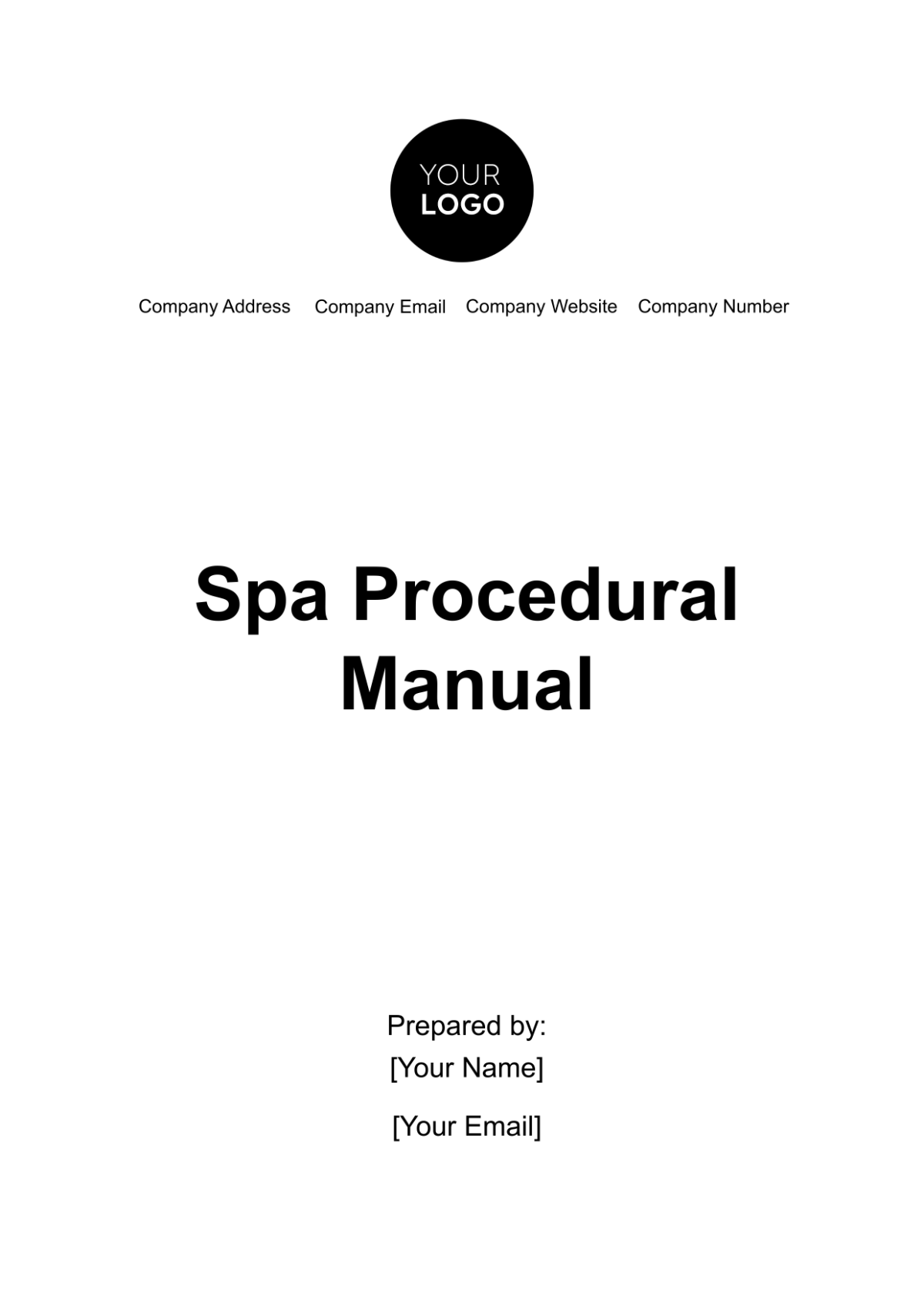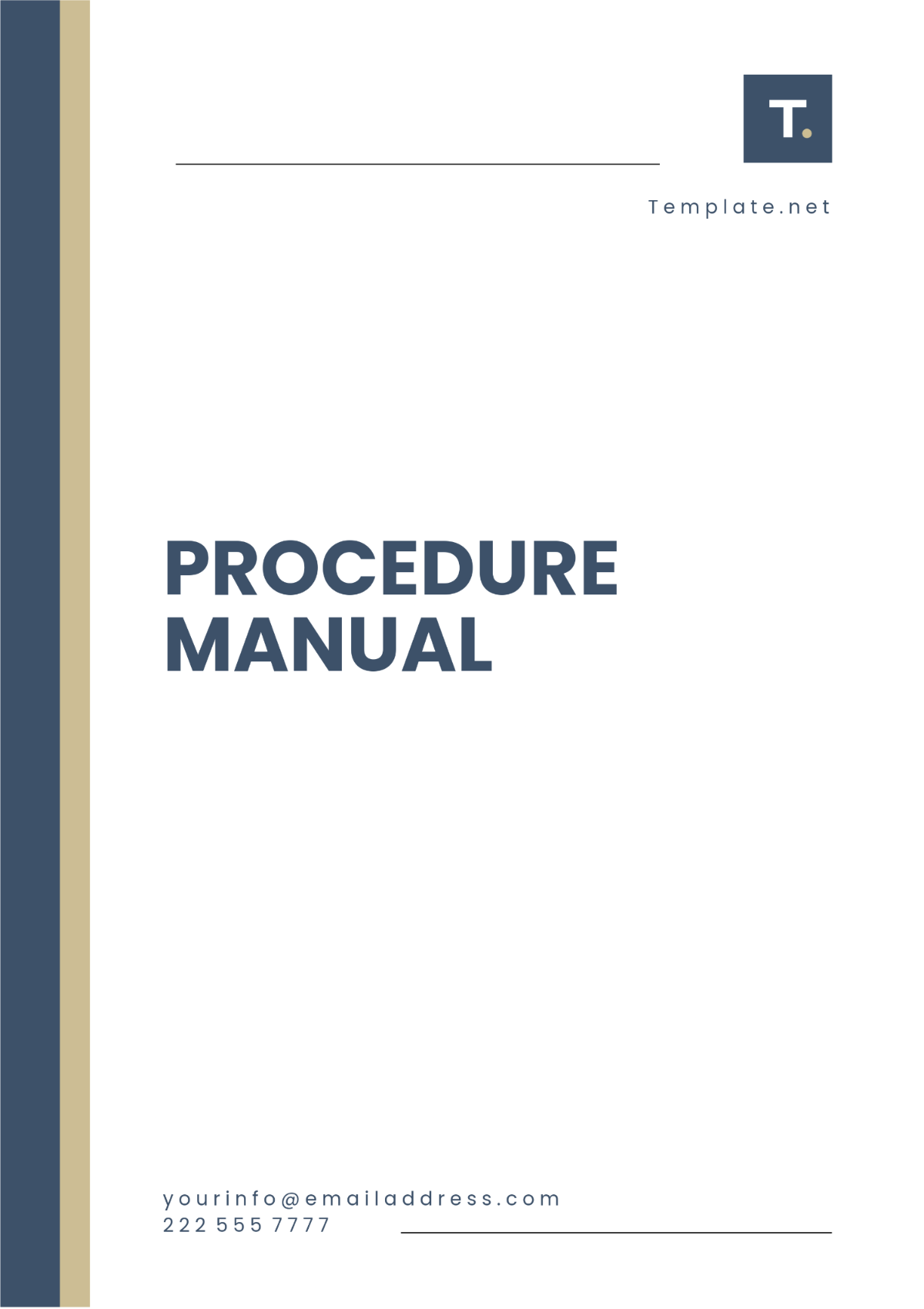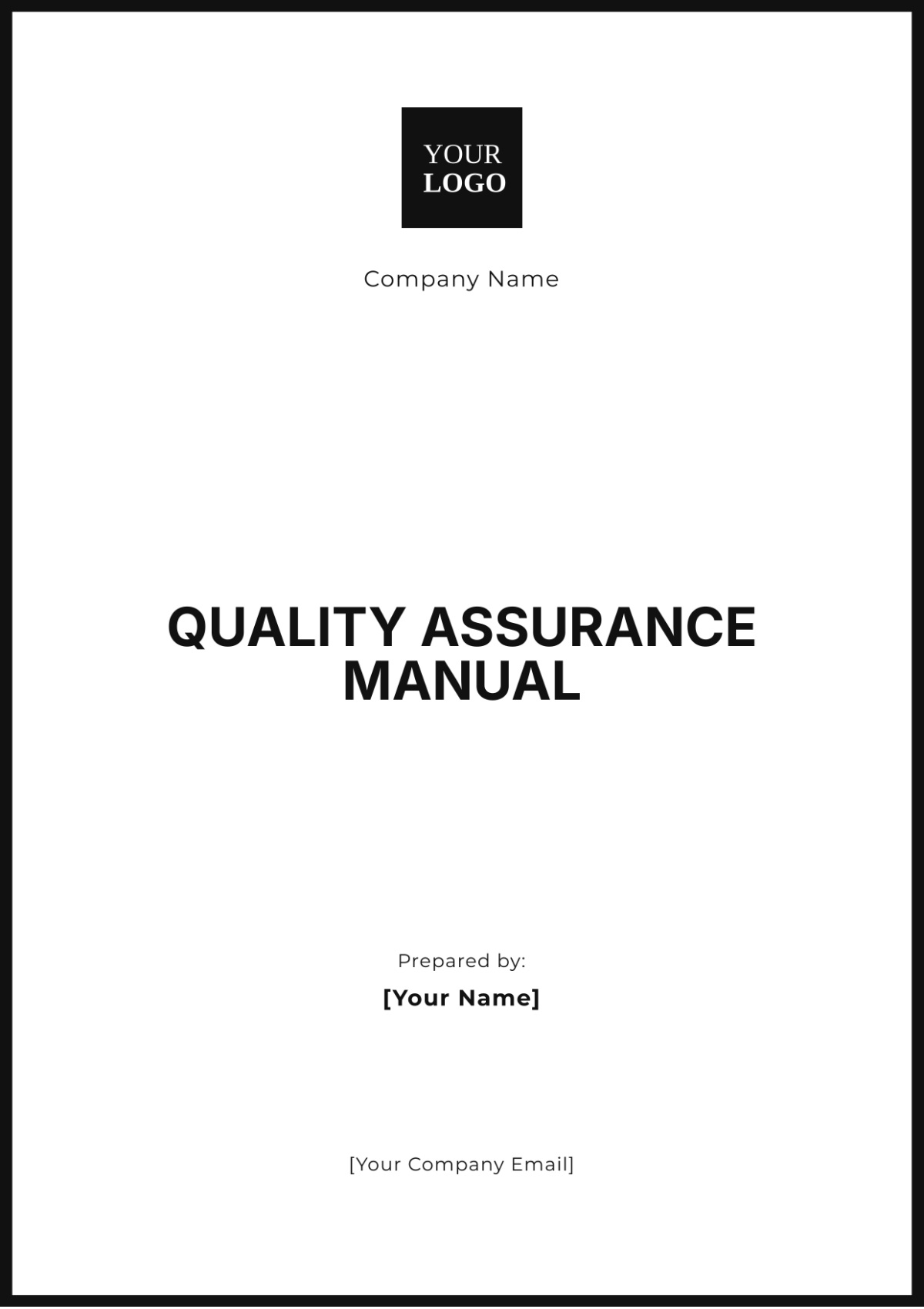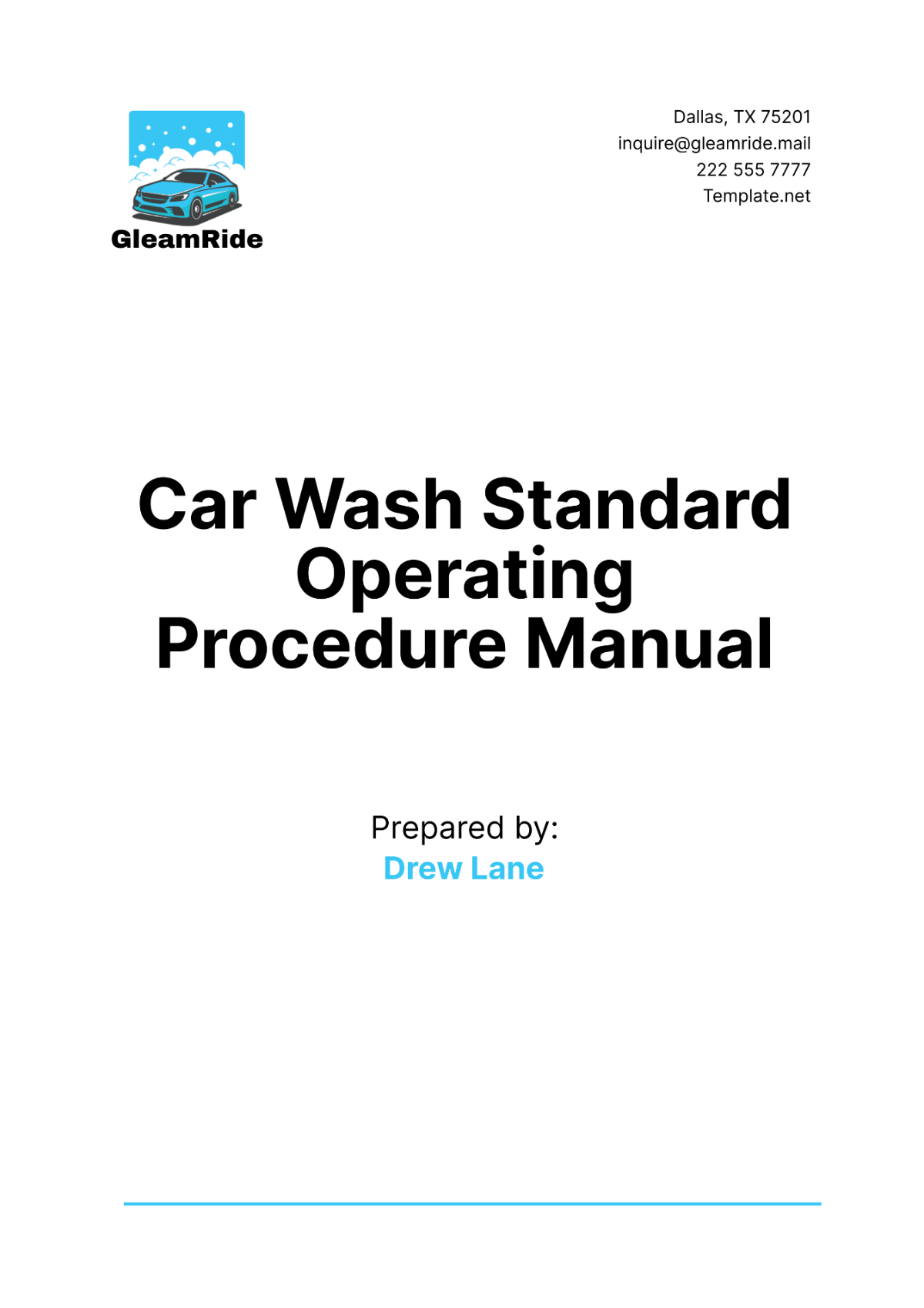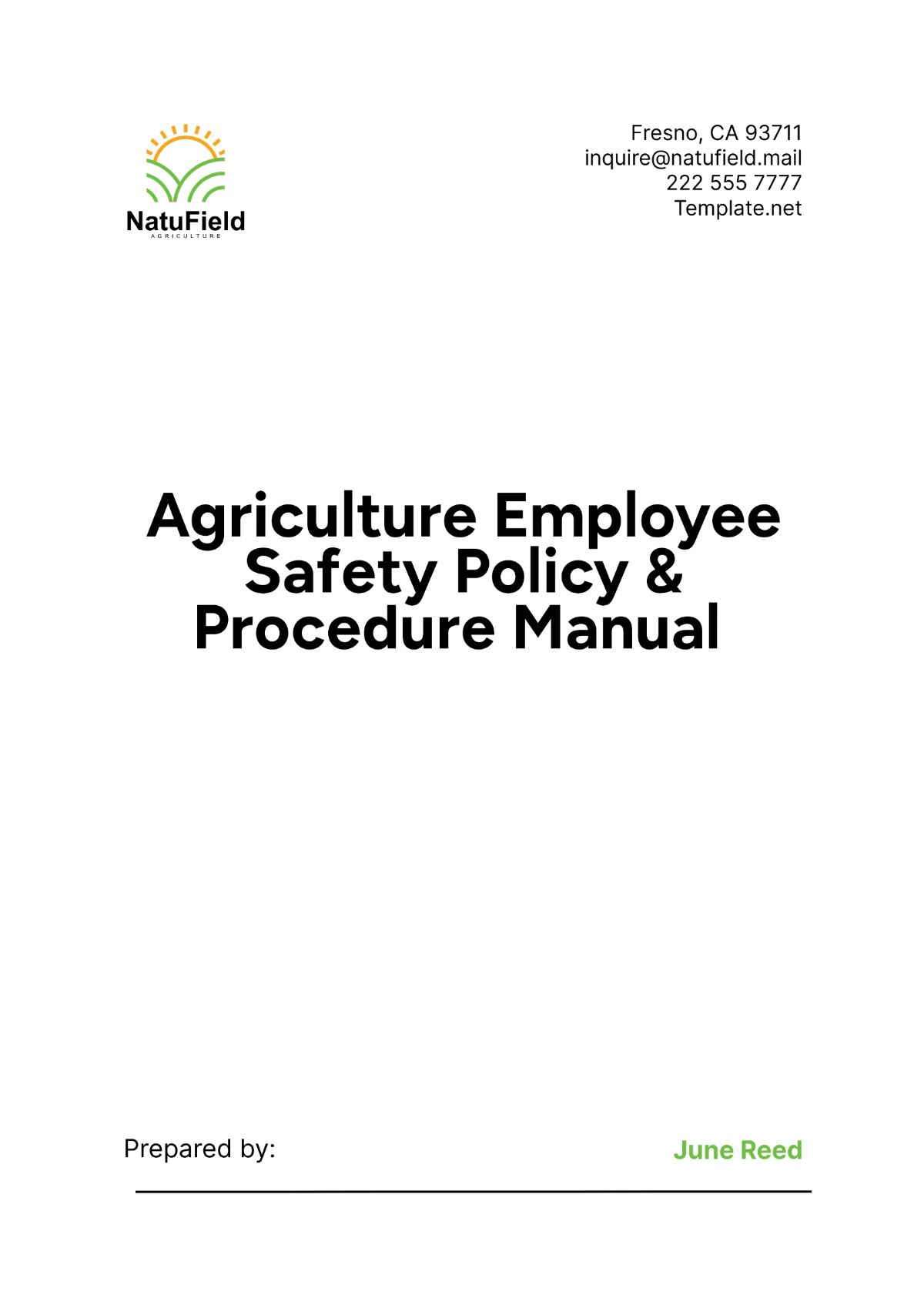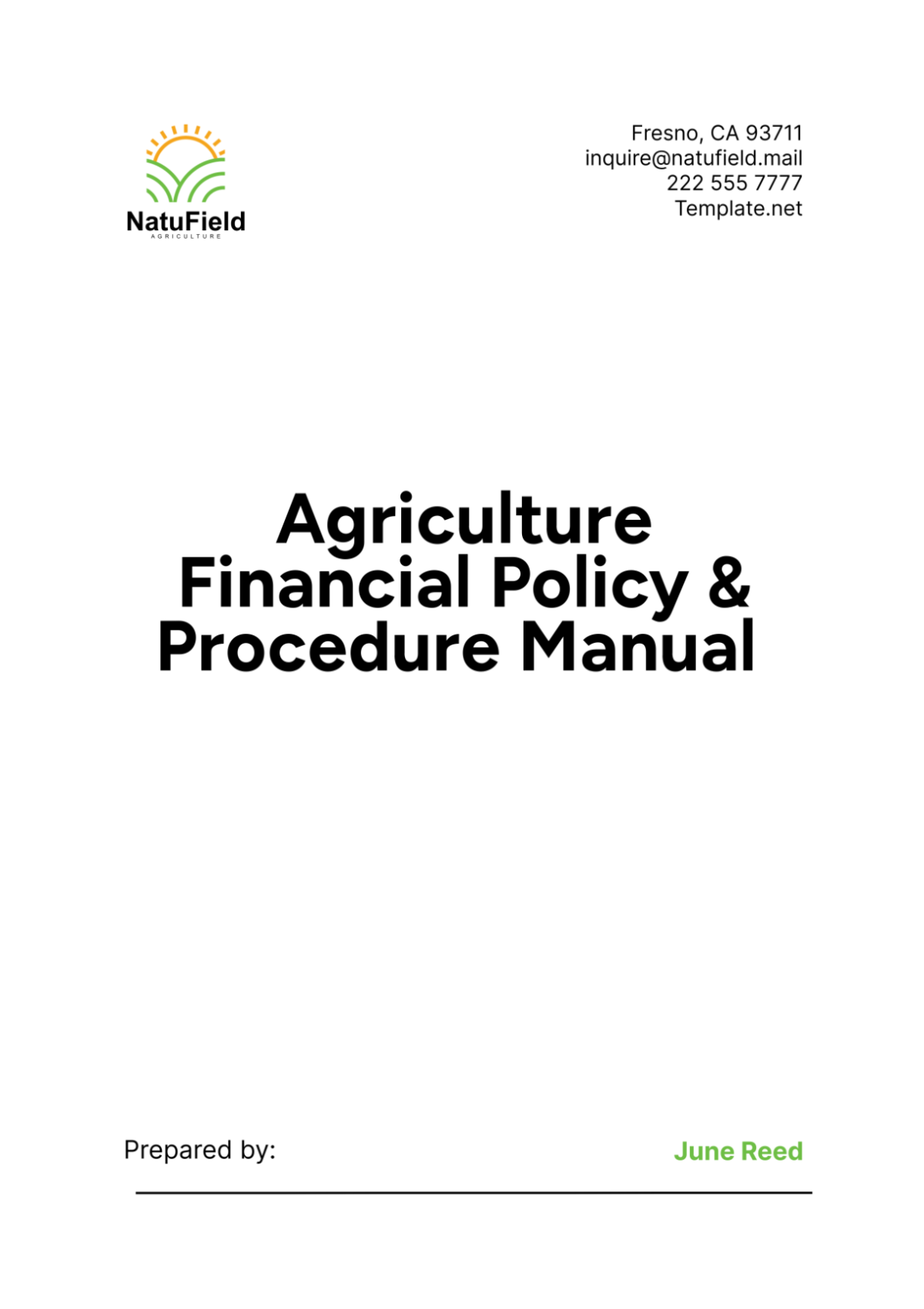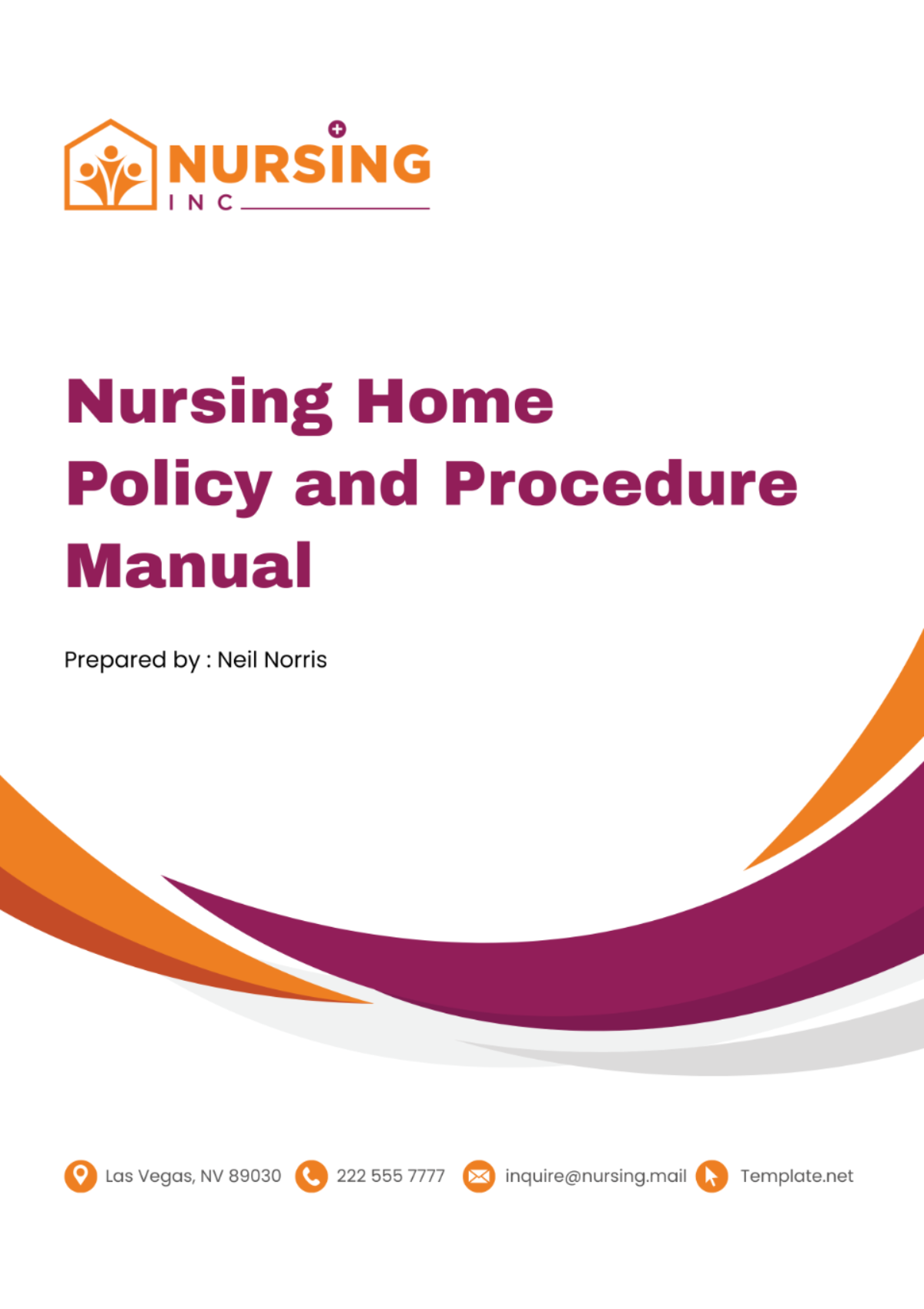Nursing Home Policy and Procedure Manual
1. Introduction
1.1 Overview of the Manual
This manual serves as a comprehensive guide for the policies and procedures governing the operation of [Your Company Name] Nursing Home. It is designed to ensure all staff understand their roles and responsibilities and to promote a high standard of care for all residents.
1.2 Purpose and Scope
The purpose of this manual is to provide staff with the information needed to perform their duties effectively while ensuring compliance with state and federal regulations. This document applies to all employees, volunteers, and contractors working within the facility.
1.3 Legal Framework and Compliance
[Your Company Name] operates under the regulatory framework established by the State Health Department, and all procedures herein are designed to comply with the following regulations:
The Nursing Home Care Act
HIPAA for privacy and security of patient information
OSHA standards for workplace health and safety
1.4 Amendments and Updates
This manual is subject to periodic review and updates as required by changes in law or operational requirements. All amendments must be approved by the Facility Director and communicated to all staff.
2. Organizational Structure
2.1 Ownership and Management
Owner: [Owner's Name]
Facility Director: [Director's Name]
Medical Director: [Medical Director's Name]
2.2 Roles and Responsibilities
Detailed roles and responsibilities for key positions are outlined in the following table:
Position | Responsibilities |
|---|---|
Facility Director | Oversees facility operations, staff management, and regulatory compliance. |
Medical Director | Ensures the quality of medical care, oversees medical staff, and coordinates with external healthcare providers. |
Nursing Staff | Provides daily care to residents, administers medications, and monitors health status. |
3. Admission and Resident Care
3.1 Admission Criteria
Residents must meet the following criteria:
Age 65 or older, or younger with significant disabilities.
Requires assistance with daily living activities or medical supervision.
Does not pose a safety risk to self or others.
3.2 Assessment Procedures
Once admitted into our facility, every single resident is required to undergo a comprehensive and thorough assessment. This will involve an evaluation of their overall medical history, encompassing all past and current health issues and treatments. Additionally, there will be a close examination of their physical well-being and their mental health in order to gauge their current state of mind and any potential psychological concerns. The assessment will also extend to social needs, so as to understand what kind of interactions and activities are most suitable for their overall wellness and happiness. All of this in-depth information will be utilized to create and implement an individualized care plan, specifically designed to address their needs and enhance their quality of life during their stay.
3.3 Resident Rights and Responsibilities
Residents have the right to:
Receive respectful and nondiscriminatory care.
Be informed about their care and treatment.
Privacy and confidentiality of their medical records.
Residents are responsible for:
Following the care plan developed with their healthcare provider.
Respecting the rights and property of other residents and staff.
3.4 Individual Care Planning
Every resident in our care will have a uniquely tailored plan of care that will be crafted in accordance with the findings of their preliminary assessment. This personalized plan of care, designed expressly for them, will be meticulously assessed, revisited, and revised on a quarterly basis. Moreover, should there be remarkable changes in such residents' overall health or condition at any point in time, the said plan will be promptly updated to meet emergent needs.
3.5 Ongoing Resident Assessment and Care Monitoring
In order to confirm that the care plan remains appropriate as time goes on and to guarantee that residents are receiving the care they need as their personal needs continue to change and evolve, regular evaluations and assessments will be systematically carried out.
4. Staffing Policies
4.1 Hiring Practices
[Your Company Name] employs a rigorous hiring process to ensure candidates are qualified and suitable for their roles. This includes background checks, verification of certifications, and assessment of fit with our community’s values.
4.2 Staff Qualifications and Requirements
All individuals employed as part of the nursing staff in this facility are required to possess and maintain a valid nursing license. Additionally, it is compulsory that all nursing staff members also have, at the bare minimum, two years of experience in caring for elderly or geriatric patients. Furthermore, it is also essential for all members of the medical staff, not just nursing personnel, to continually enhance their knowledge and skills in the realm of elderly care practices. This ongoing education is a requirement, keeping up-to-date on the best and latest practices related to caring for the elderly.
4.3 Orientation and Training
New employees are required to go through a comprehensive orientation that spans over a period of two weeks. This initiation process includes a thorough overview and understanding of the policies of the facility. They are also educated about the procedures that need to be followed while caring for the residents. Further, they receive practical, hands-on training under the guidance and supervision of the well-experienced and seasoned members of our staff.
4.4 Staff Scheduling
Staffing schedules are designed to ensure adequate coverage at all times. A monthly schedule is published and includes rotations for weekends and holidays to ensure fairness and compliance with labor laws.
4.5 Performance Evaluation and Management
The performance of the staff members is assessed once every year. This evaluation primarily revolves around numerous vital aspects including the quality of care they provide to the residents, their adherence to the established rules and regulations of the institution, as well as the feedback received from the residents regarding their performance. If a staff member is identified as continuously performing poorly, suitable steps are taken to address this. This may involve providing them with additional training to improve their skills. In cases where further measures are required, disciplinary action could be taken if deemed necessary.
4.6 Employee Health and Safety
At [Your Company Name], our commitment to maintaining a safe and secure work environment is unwavering and is of paramount importance to us. We firmly believe that all our employees have a fundamental right to a workspace that is free from hazards. To ensure this, we have in place several safety protocols that all employees are expected to comply with diligently. In the unfortunate event of any workplace injuries, our policy mandates these to be reported immediately so that appropriate steps can be taken to address the situation. Furthermore, our commitment to safety is not stationary. We believe in continuous education and, thus, provide regular training sessions on various safety practices. These training sessions are not optional; instead, they are mandatory for all employees as we consider being informed and aware as the primary step towards ensuring safety.
5. Medical Management
5.1 Medication Administration
All medications must be administered by qualified nursing staff according to physician orders. The following table summarizes the medication management process:
Step | Description |
|---|---|
Verification | Confirm the correct medication and dosage as per the physician’s order. |
Preparation | Prepare medications using appropriate hygiene techniques. |
Administration | Administer medication observing the right time, dose, route, and person. |
Documentation | Record the administration details, noting any side effects or issues. |
5.2 Medical Records Management
Medical records are maintained to ensure confidentiality and accuracy. They include patient history, treatment records, and communication logs. Records are stored securely and are only accessible to authorized personnel.
5.3 Emergency Procedures and Protocols
Emergency protocols are in place for handling critical medical situations. Staff are trained in basic life support, and emergency equipment is checked regularly. The emergency contact list is updated bi-annually and displayed prominently in all wards.
5.4 Infection Control
The following protocols are established to prevent and control infections within the facility:
Action | Description |
|---|---|
Hand Hygiene | Mandatory hand washing/sanitizing before and after patient contact. |
PPE Usage | Use of gloves, gowns, and masks as per infection control guidelines. |
Cleaning | Regular disinfection of surfaces and equipment. |
5.5 Handling Medical Equipment
Explicit procedures and guidelines have been established and documented for the appropriate utilization and maintenance of medical equipment used in our facility. In turn, all staff members who are in direct contact with this equipment are thoroughly trained based on these procedures. This ensures that they are aware of and capable of following the correct use and maintenance procedures. We adhere meticulously to the maintenance schedules that were established and are in place for each piece of equipment. This close adherence is imperative as it ensures the consistent reliability of our equipment. Furthermore, it safeguards the safety of both our staff who operate the equipment and the patients who are treated with it.
6. Resident Safety and Welfare
6.1 Fire Safety Procedures
Every quarter, fire drills are conducted as part of safety measures. In accordance with these procedures, evacuation plans are prominently posted in each room so they are easily visible to all. Furthermore, on a yearly basis, all staff members undergo fire safety training to ensure they are up-to-date with the necessary knowledge and skills. This is to provide the utmost safety and precaution in case of fire emergencies.
6.2 Disaster Preparedness
The facility is equipped with an inclusive disaster preparedness plan, with a focus that extends to situations that might include earthquakes, floods, and power outages. As a part of the preparation process, emergency supplies are kept within the vicinity of the facility. The validity and efficiency of the plan are maintained by conducting a thorough review and making necessary updates on an annual basis.
6.3 Fall Prevention
Several programs have been implemented with the primary purpose of minimizing the risk of falls within our facility. These programs include regular and thorough assessments of each resident's mobility. We continuously monitor and evaluate their aptitude to move around safely and without assistance. In addition, we run consistent checks on environmental safety within our facility to ensure there are no hazards that could potentially cause falls or injuries. As part of our continuous efforts to ensure safety and prevent accidents, we have installed non-slip mats and handrails all over the facility. This allows residents to have sturdier grips and more sure footing while navigating within the facility.
6.4 Security Measures
Security personnel are positioned at all entrance points of the premises, and they are stationed there round the clock, 24 hours a day, 7 days a week without interruption. Additionally, surveillance cameras are employed throughout all the common areas, constantly monitoring and recording activities. Furthermore, the exits are equipped with alarm systems that are set to trigger in case of any incidents or irregularities.
6.5 Reporting and Managing Incidents
Any incidents or accidents are immediately documented and investigated. The following table outlines the incident reporting process:
Step | Description |
|---|---|
Identification | Staff identifies and documents the incident. |
Reporting | Immediate report to the supervisor and documentation in the incident log. |
Investigation | A thorough investigation is conducted to understand the cause and prevent recurrence. |
Resolution | Appropriate measures are taken to resolve any issues. |
7. Nutritional Services
7.1 Dietary Planning and Management
Meals are planned by a certified dietitian to ensure they meet the nutritional needs of all residents, including those with specific dietary restrictions such as low sodium or diabetic diets. Menus are planned on a four-week cycle and reviewed quarterly to incorporate seasonal variations and resident feedback.
Week | Meal | Special Diet Consideration |
|---|---|---|
1 | Chicken with rice and vegetables | Available in low-sodium |
2 | Beef stew with whole grain bread | Gluten-free bread available |
3 | Baked fish with sweet potato mash | Textured modified as needed |
4 | Vegetarian chili with cornbread | Vegan option available |
7.2 Meal Preparation and Service
Kitchen operations are overseen by a head chef trained in geriatric nutritional needs. All kitchen staff are required to hold food safety certifications and participate in monthly training sessions to stay updated on best practices in food hygiene and safety. Meals are prepared in a clean environment that complies with all local health codes.
7.3 Special Diets and Allergies
A detailed record of individual dietary needs and allergies is maintained for each resident. These requirements are integrated into the meal planning process to ensure that appropriate meals are provided without cross-contamination. Communication between nursing staff and kitchen personnel is facilitated through daily meetings and digital logs.
7.4 Food Safety and Hygiene
The facility adheres to strict food safety protocols, which include regular kitchen inspections and compliance audits by third-party health inspectors. Cleaning schedules for kitchen areas are strictly followed, with surfaces sanitized after each meal preparation session.
Task | Frequency | Notes |
|---|---|---|
Surface cleaning | After each use | Using approved sanitizers |
Deep cleaning | Weekly | Focus on appliances and storage areas |
Pest control inspection | Monthly | Conducted by licensed professionals |
8. Housekeeping and Maintenance
8.1 Cleaning Protocols
Housekeeping staff follows detailed cleaning checklists that specify tasks to be completed in each area of the facility. These checklists are designed to ensure a high standard of cleanliness to maintain a healthy living environment for residents.
Area | Tasks | Frequency |
|---|---|---|
Resident rooms | Dusting, vacuuming, bathroom cleaning | Daily |
Common areas | Dusting, vacuuming, window cleaning | Twice daily |
Medical areas | Disinfection of surfaces and equipment | After each use |
8.2 Maintenance of Equipment
Preventative maintenance is scheduled for all facility equipment, from HVAC systems to resident call systems, ensuring they are in good working order. A logbook is maintained documenting each piece of equipment, the date of maintenance, and any repairs made.
8.3 Laundry Services
Laundry services are provided with separate machines for resident clothing and facility linens to prevent cross-contamination. Temperatures are monitored to ensure effective sanitization and hypoallergenic detergents are used for residents with sensitive skin.
8.4 Waste Management
The facility implements a comprehensive waste management program that includes the separation of recyclables, general waste, and medical waste. Staff are trained in proper disposal methods to comply with environmental standards.
Type of Waste | Disposal Method | Handling Instructions |
|---|---|---|
Recyclable | Recycling bins | Rinse and sort by type |
General | Compacted bins | Bagged and tied securely |
Medical | Biohazard containers | Wear gloves; double bag if necessary |
9. Quality Assurance
9.1 Compliance Audits
Annual internal and external audits assess compliance with healthcare standards and identify areas for improvement. Results are reported to management and an action plan is developed to address any deficiencies.
9.2 Resident Satisfaction Surveys
Surveys are carried out with the purpose of gaining a deeper understanding of the residents' levels of satisfaction with their living environment, the care they have been receiving, and the quality and variety of meals that are provided to them. Once the surveys have been completed and collected, the Quality Assurance team undertakes a comprehensive analysis of the obtained results. This process involves detailed examinations of all feedback given by residents to identify areas that may be in need of improvement. Following this analysis, measures are then implemented to address any issues that have been highlighted and to continually enhance the living standards of all residents. Adjustments and improvements being done are all based on the feedback gathered from individual residents.
9.3 Continuous Improvement Programs
Meetings are held every quarter with staff members from all departments in order to discuss the operational challenges the facility may be facing and propose potential solutions. The intention behind these meetings is to foster an environment that encourages continuous improvement and innovation within the facility. This culture of continuous improvement is significant as it drives the facility toward realizing its objectives in a more effective and efficient manner.
9.4 Staff Training and Development
A yearly training calendar is established for all staff, focusing on skills enhancement, regulatory compliance, and personal development. Training sessions are led by experts in the field and cover a wide range of topics from resident care techniques to emergency response.
10. Legal and Ethical Issues
10.1 Compliance with Health Care Laws
The facility maintains an up-to-date compliance program to adhere to all local, state, and federal laws affecting nursing home operations. Regular training sessions on legal compliance are mandatory for all staff.
10.2 Resident Confidentiality and Privacy
Policies are in place to protect the confidentiality and privacy of resident information. Staff are trained in HIPAA compliance annually, and audits are conducted to ensure proper handling of sensitive information.
10.3 Handling Complaints and Grievances
An established formal grievance procedure provides a secure and confidential framework within which residents and their families can report their concerns. In this system, every reported complaint receives a comprehensive investigation to assess its nature and effect. Following this investigation, corrective actions are introduced and implemented in a timely manner designed to swiftly resolve the reported issues.
10.4 Ethical Decision-Making
Training on ethics involves presenting different scenarios that the staff members might potentially encounter in the course of their duties. Alongside these scenarios, guidelines are provided that direct the staff on the appropriate manner to manage these situations. It is imperative that these guidelines emphasize the importance of handling every situation in such a way that both the dignity and the rights of all residents are respected and upheld.
11. Financial Management
11.1 Budgeting and Financial Planning
The process of annual budgeting encompasses the participation of all department heads. This is done to make certain that all financial resources are allocated in the most efficient way possible in order to accommodate the needs of the residents. In addition to this, a review of financial performance is conducted on a monthly basis as a means of comparison against the predicted budget forecasts.
11.2 Billing and Payment Processing
A well-structured and efficient billing system is in place to make sure that all resident fees, insurance claims, and other forms of payments are processed accurately and punctually. This helps eliminate any chances of delays or discrepancies. In order to prevent errors and maintain complete transparency, this system undergoes regular audits. This allows for consistent checks and balances, as well as, corrective measures if needed. By doing so, the system ensures seamless financial management and builds trust among all stakeholders.
11.3 Handling Resident Funds
Policies for managing the personal funds of residents include secure storage, accurate tracking of deposits and withdrawals, and regular statements provided to residents or their designated representatives.
12. Communication and Reporting
12.1 Internal Communication Procedures
An effective and robust internal communication system is marked by several factors. Among these are daily briefings that take place during shift changes. This is a crucial aspect as it enables smoother transitions between teams. Additionally, the said system could also include a monthly newsletter as another medium for information dissemination. This can keep the staff updated on the latest happenings, policies, and announcements. Furthermore, a digital message board is also part of this system. The purpose of this board is to provide an avenue for staff to access updates and alerts in real time, ensuring that everyone stays informed at all times, given the dynamic nature of the organization.
12.2 Reporting to Regulatory Bodies
The relevant regulatory bodies are regularly provided with comprehensive reports. These reports detail various aspects such as compliance with the care standards established for the institution, incident reports that document any unusual or notable occurrences within the institution, and audit outcomes that highlight the fiscal responsibility of the institution. These comprehensive reports are submitted as required, ensuring that the regulatory bodies in question have all the necessary and pertinent information they require for their regulatory functions.
12.3 Family and Community Engagement
Regular family nights, community events, and open houses foster strong relationships between the facility, residents, and the local community. Feedback from these events is used to improve facility services and engagement strategies.












